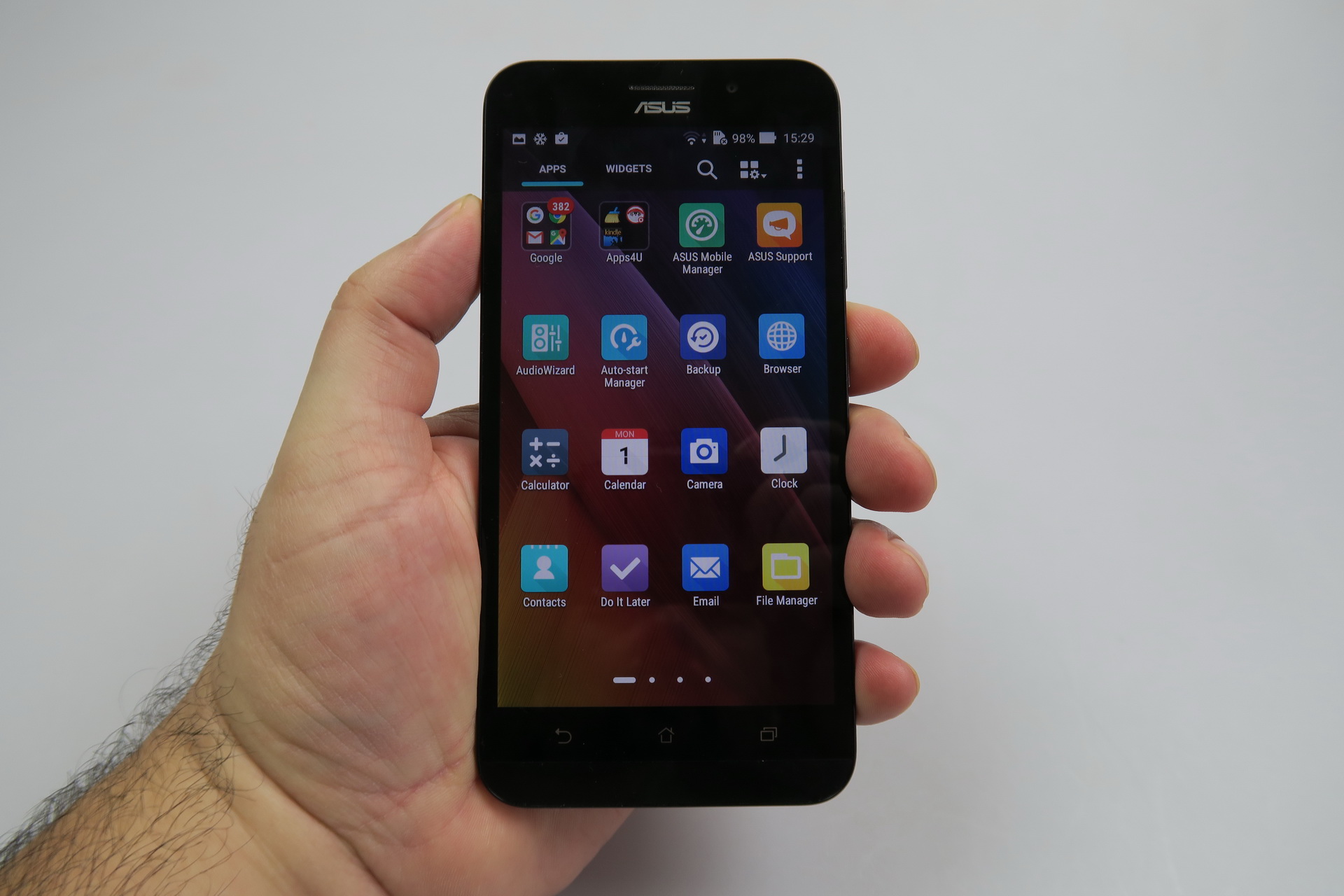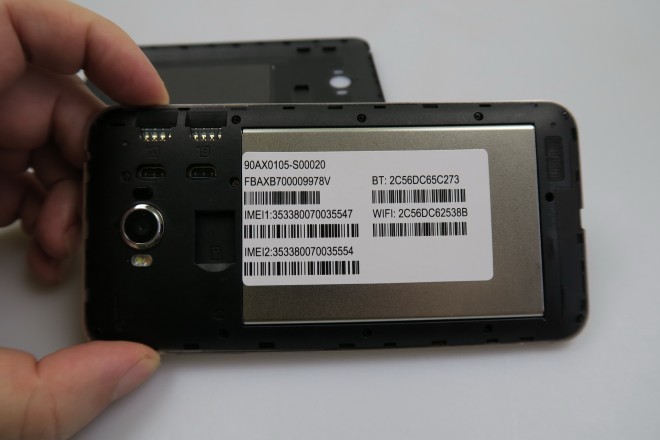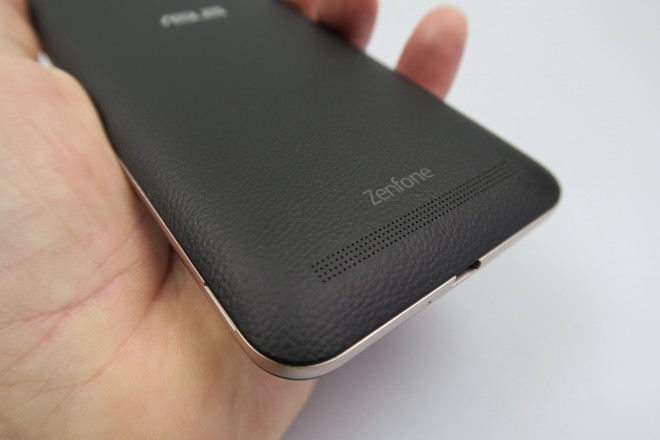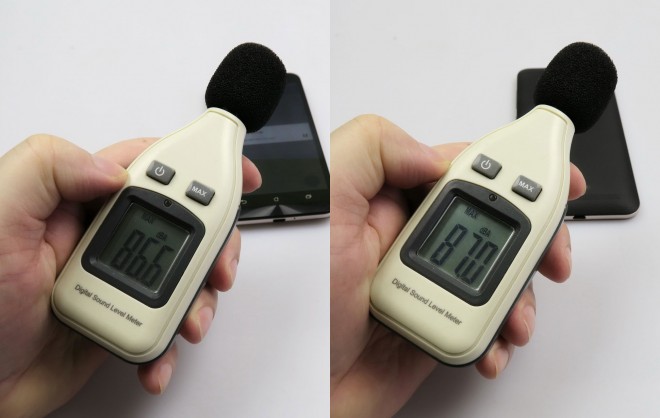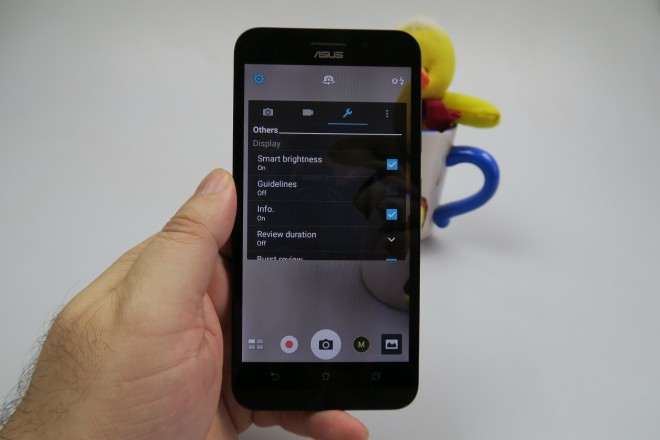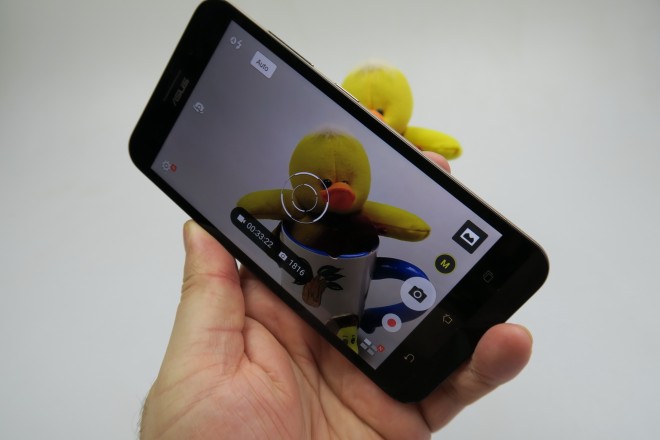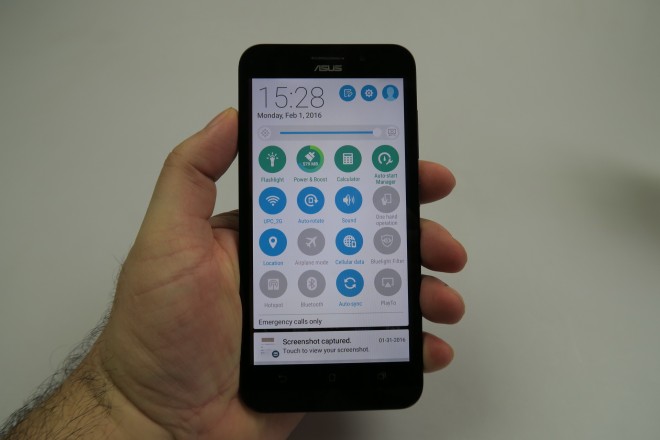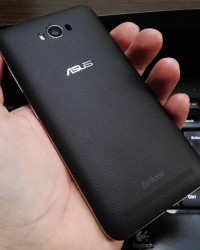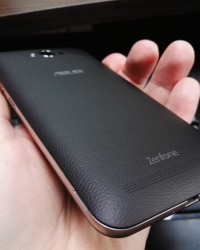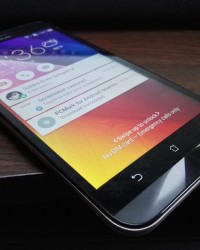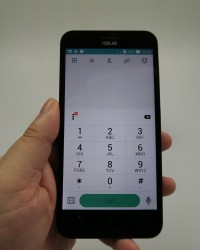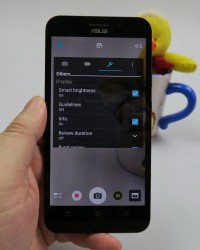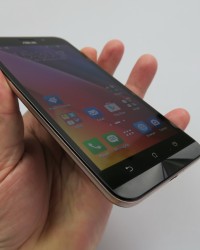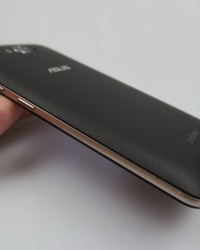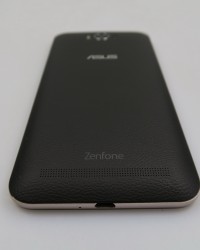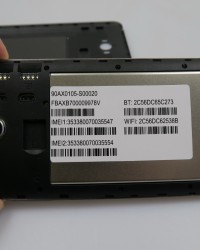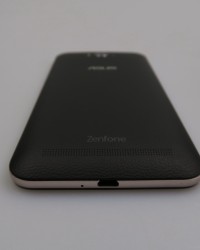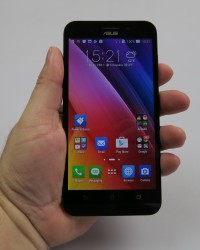After the year 2015, that brought us some of the most interesting ZenFones to test, including the ASUS ZenFone 2, ZenFone 2 Laser and ZenFone Selfie, it’s time to start 2016 with a review of the ASUS ZenFone Max. This model reached us, in the ZC550KL version, which is a battery phone with a beefy 5000 mAh unit and the same camera as the ZenFone 2 Laser.
Launched internationally in January, this phone is priced at $147 (more prices on Amazon) and measures 10.55 mm in thickness, while also weighing 202 grams. It comes in black or white and while it’s thicker than the Gionee Marathon M5 (8.5 mm), it’s also lighter by 10 grams. It’s a sturdy and massive device, that doesn’t feel very heavy in the user’s hand.
It’s got a leather imitation back, good grip and the one hand usage is out of the question, since it’s a big phone. The front side design is typical for a ZenFone and we’ve got a plastic frame in the mix, in case you’re wondering. Still, it’s a solid machine. Upfront the following elements are present: earpiece, front camera, notification LED, sensors, 3 capacitive buttons and big bezels.
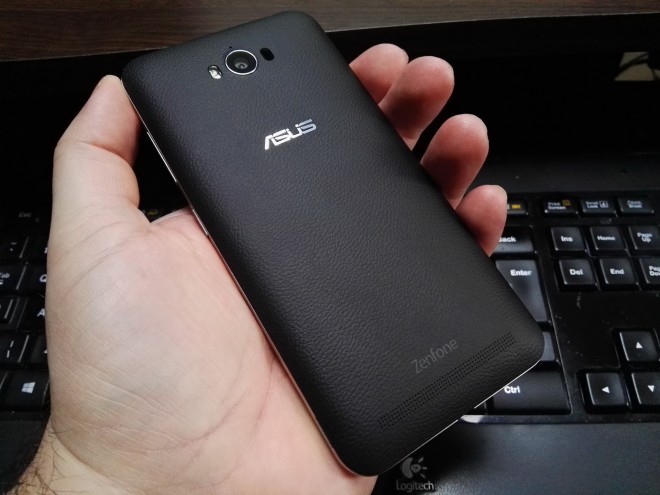
The back includes the main camera, flash, laser focus mechanism, microphone, speaker and once the back side is removed (quite hard, by the way), you’ll see the non removable battery and 2 SIM slots and one microSD slot. Then there’s the audio jack at the top and at the bottom ASUS integrated the microUSB port and microphone.
Nothing on the left side, while the right includes the Power and volume buttons, the latter usually present at the back of ZenFones. These buttons are quite comfy here. Overall, the ASUS ZenFone Max is a solid, but plasticky phone and sometimes it creaks a bit, but only a bit. Now, as far as hardware goes, the phablet packs a 5.5 inch IPS screen with 720p resolution and a quad core Qualcomm Snapdragon 410 processor, clocked at 1.2 GHz.
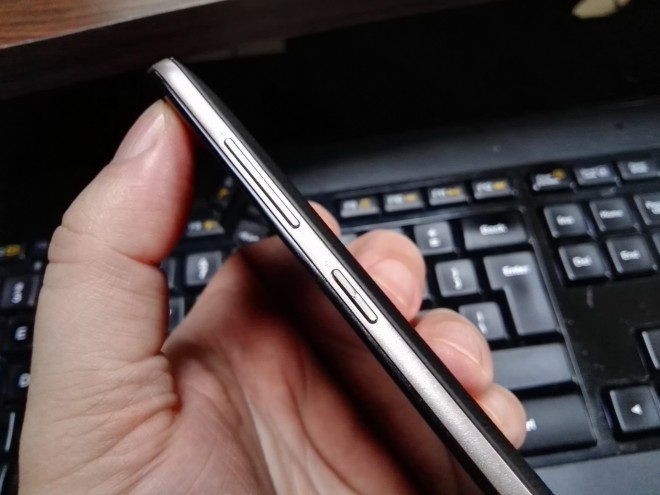
Specs also include 2 GB of LPDDR3 RAM, the Adreno 306 GPU, 16 GB of storage, a microSD card slot and 5 GB of ASUS WebStorage. The back camera is a 13 MP unit, while the front one has a 5 MP resolution. On the connectivity front, we get WiFi 802.11 b/g/n, microUSB, Bluetooth 4.0, dual microSIM card slots and 4G LTE of the Category 4 kind, with up to 150 Mbps download speed.
There’s also GPS and Glonass available among the specs. Sensors are the following: accelerometer, e compass, proximity and ambient light sensor, as well as hall sensor. ZenFone Max has the 5000 mAh as its key feature, promising on paper 914 hours of standby functioning, or 37.63 hours of talk time. During our test, that involved HD video playback in a loop, with WiFi on and brightness at 200 LUX, we achieved 19 hours and 35 minutes, which is huge.
Still, we scored below the Gionee Marathon M5, with its 22 hours and 24 minutes, but that model costs more. We beat the Nokia Lumia 1520 (17 hours), iPhone 6S Plus (15 hours and 8 minutes) and Allview P6 Energy (12 hours and 9 minutes). Meanwhile, the PCMark battery test brought us an absolute record of 16 hours and 24 minutes of continuous usage, beating all the phones we’ve ever tested.
That includes the Gionee Marathon M5 (16 hours and 20 minutes), Allview P6 Energy (11 hours and 24 minutes) and ASUS ZenFone 2 Laser (8 hours and 16 minutes). Charging lasts quite a long time, 4 hours and 40 minutes, but it’s well worth it. This is actually the longest time of charging we’ve ever measured for a phone and that’s certainly no compliment.
It’s even longer than the Philips Xenium i908 (4 hours and 25 minutes), Allview P6 Energy (4 hours) and Microsoft Lumia 640 XL LTE (4 hours). Settings offer us access to Power Management options, like these Modes:
- Performance: high CPU and brightness
- Normal: smart adjustment to CPU and brightness
- Power Save: network is disabled in sleep mode
- Super Saving: just use phone, SMS, alarm and no network, plus basic UI
- Custom: tweak CPU, brightness and network, each with options and extend standby.
There’s also Smart Switch, that lets you active one of the modes above at a certain percentage or by a schedule. Finally, we’ve got Auto Start Manager and this model can also work as a power bank for other devices. I’d say that aside from the long charging, this smartphone is basically perfect battery-wise.
Now let’s talk acoustics! We didn’t get headphones with this test version and we’re using a pretty small speaker at the back side. The Music app is typical for Zen UI and it includes a Sleep Timer and Settings for Theme and an equalizer, with options like volume, bass, treble and dialog enhancement. There are also 5 custom channels to tweak with sliders.
The actual listening experience involved a loud volume, some distortion and not much bass. The guitar was good and there’s no muffling. We’ve got FM radio and the decibelmeter showed a value of 86.6 dBA at the front and 87 dBA at the back. This means we surpassed the LG AKA (86.4 dBA), Samsung Galaxy Note 4 (85.6 dBA) and ASUS ZenFone Selfie (85.5 dBA).
We scored below the Samsung Galaxy S6 (89 dbA), ASUS ZenFone 2 (89.1 dBA) and OnePlus One (90.5 dBA). The Audio Wizard app has the following use modes: Movie, Music, Gaming, Vocal and Smart, each with its own effects applied. Now we have reached the display analysis section. ASUS ZenFone Max packs a 5.5 inch IPS LCD screen with 1280 x 720 pixel resolution, Gorilla Glass 4 protection and anti fingerprint layer on top.
It offers 178 degree view angles, full lamination technology and relies on a Sharp panel technology. The display has a 267 ppi density. The video player of choice is the Gallery and when using the screen for playback, we registered a bright and clear experience, vivid colors, good contrast and wide angles. Sunlight behaviour was OK.

The display uses RGB Stripe pixels and when we did the luxmeter test we achieved 304 LUX, that while modest, at least it surpasses the underwhelming ZenFones from last year. We beat the ASUS ZenFone Selfie (285 LUX), ASUS ZenFone 2 Laser (274 LUX) and LG G Flex 2 (266 LUX), but scored below the ASUS ZenFone 2 (323 LUX), Huawei P8 (346 LUX) and Gionee Marathon M5 (471 LUX).
The display has settings such as brightness, font (style and size) and Screen Color Mode. That one includes a color temperature slider and these Modes: Balance, Blue Light Filter (slider included), Vivid and Custom (hue and saturation sliders). Overall, I’d say the screen is OK, especially after having evolved from last year’s models.
Now we focus on the camera! ZenFone Max has a main 13 MP shooter, with PixelMaster technology, F/2.0 aperture, laser autofocus and it’s the very same module that the ZenFone 2 Laser included. It has a Toshiba sensor, with 0.03 second autofocus and dual LED real tone flash. The 5 MP front camera has an 85 degree angle lens and F/2.0 aperture too.
The camera app is fast to start and what greets us is the typical Zen UI, this time with a manual options shortcut next to the shutter. To the left we find the flash options, front camera shortcut and Settings like white balance, ISO, exposure, optimization (manual or auto), resolution (13 MP in 4:3 or 10 MP in 16:9).
There’s also Anti Shake, Image Quality, Time Stamp, Touch Shutter, Self Timer, Burst, Focus (Smart Continuous and Infinity), as well as metering. Video options are: white balance, exposure, resolution (Full HD or HD), touch auto exposure and preference (performance or quality). To the right there are the Modes, a very rich List: Auto, Manual, HDR, Beauty, Super Resolution (52 megapixel), Low Light, Night, Depth of Field, Effect, Selfie, GIF, Panorama, Miniature, Time Rewind, Smart Remove, All Smiles, Slow Mo and Time Lapse.
The Manual mode also brings extra options, such as Histogram, alignment and sliders for white balance, exposure, ISO (up to 800), shutter speed (1/1000 seconds to 1/2 seconds), autofocus (macro to infinity). When using the front camera, you can use options like cheek thinning, eye enhance, blush and selfie panorama.
The focus is very fast and the zoom feels a bit laggy. If you keep the screen pressed, you will activate the autofocus, auto white balance and auto exposure lock mechanism. There’s an exposure slider as well included. The day photo gallery was taken on a sunny February day and featured a first shot that was blurry and the HDR then looked washed out.
Then we took the Super Resolution shot, with 8192 x 4608 pixel resolution and great level of detail. Colors were vivid and realistic and we took some landscape shots, that had nice details, even when zoomed in. Pictures looked OK even in full sunlight and we registered no blur, but there were some white-ish frames. Closeups were very clear and had great details, too.
Selfies were reasonably good, but there was too much beautification going on, with a decent background. Panorama was wide, with a 9600 x 880 pixel resolution and it was also pretty crisp. Overall, we had good exposure, white balance and focus and the closeups of the locket and that metallic nut had excellent texture.
Even though we have the same camera on this model as on the ASUS ZenFone 2 Laser, there were times when I felt that the ZenFone Max was slightly superior. We also tried out some shots during the night time, achieving very good colors, when the flash was on. Street light halos were kept to a minimum and shots were clear even without flash.
Night mode and Low Light mode made matters a bit grainier, albeit brighter. Closeups were just as great as night, as they were during the day. I’d say this camera can easily fight the iPhone 6, even at night and it’s still slightly a bit below the ZenFone 2 Laser in low light. Overall, it beats the ZenFone 2, and fights the Huawei champions in the same weight class.
Now let’s talk about the video. We filmed in MP4 format, in Full HD, at 30 FPS and 20 Mbps bitrate. The first video we shot was shaky and windy, plus slightly dark and registered OK colors and good clarity. Then came a clip with perfect colors, crisp image and some refocusing issues. Video 3 was a slow-mo one, kind of grainy. The fourth video offered us good focus, clarity, colors and a nice focus change, when we tapped on the screen.
We also filmed at night, with the flash on and some grain, reasonable colors and some darkness. Without flash, the image gets yellow-ish, but at least the light halos are OK. I have to say that video capture isn’t bad and it beats some midrangers from the HTC Desire series, Huawei Honor and ZenFone 2. I’d say this is a great camera for a handset that costs less than $150.
The Gallery app can show pictures as Events, or even organized by the People they include. We also have collages we can create and a MiniMovie, which is basically a sort of HTC Zoe, with the same effects, soundtrack and filter options. Editing photos is done with the usual filters, frames and face tweaks. We move on to temperature, where we registered 32.8 degrees Celsius after 15 minutes of playing Riptide GP2, so there’s no overheating here.
On the connectivity side, we’re covered with WiFi 802.11 b/g/n, microUSB with OTG, Bluetooth 4.0 and dual micro SIM card slots. WiFi Direct and LTE Category 4 are also here (up to 150 Mbps download speeds), HSPA+, GPS and Glonass, too. We get Speed Dial in the dialer area, a Block List, call recording and the phone offers good signal, a clear sound, but overall it could be louder.
We measured WiFi speeds, reaching 20 Mbps in download and 22 Mbps in upload, which is good. We unified the browser and benchmark area and I have to mention that the ASUS browser includes a Speed Dial Feature, a Most Visited section and trending searches, too. The browser has a mid level speed and supports saving for offline reading. The keyboard on the ZenFone Max is quite comfy and features a Swype-style feature.
We tested the browser in benchmarks and achieved 1270 points in BrowserMark, which is not impressive and 1574 in Sunspider, which is very poor. We also compared the phone in benchmarks to the Samsung Galaxy A5 and Gionee Marathon M5 and noticed that the ZenFone Max doesn’t quite win any battle. Results are not impressive, but the phone has no lag and gets a fluid UI. Here are the benchmark results:
The boot is still kind of slow, since there are too many apps starting at once. We could run Riptide GP2 and Real Racing 3 without a problem and they worked just fine. So, overall performance is OK and now we talk about the OS, UI and apps. ZenFone Max brings Android 5.0.2 with Zen UI on top, a colorful and flat UI. Multitasking is available in carousel format, with a Pinning and Close All option.
If you keep the screen pressed, you’ll open up a huge variety of menus and options, like Apps and Widgets (with many unique widgets), plus possibilities to edit icons, icon size, alignment, wallpaper, scroll effects, font size, icon label color, icon packs, Zen U theme and many more. Layout of apps and grids are also here to tweak.

The dropdown area includes big icons for Quick Settings, a brightness slider and notifications. Then we move to Settings, with ZenMotion features, that include double tap to tweak, draw symbols to open apps and one hand mode. Other options are Do Not Disturb, ASUS Cover, ASUS Customized Settings, Easy Mode, Kids Mode and Glove Mode.
Then there’s the Apps section, the Achiles heel of the device, since there’s a TON of bloatware. At least we have Smart Group, a feature that can group apps into folders pretty efficiently. Here’s the list of apps preinstalled:
- Chrome
- Gmail
- Maps
- YouTube
- Drive
- Play Music
- Hangouts
- Photos
- Docs
- Sheets
- Slides
- CleanMaster
- Dr Safety
- Amazon Kindle
- ASUS Mobile Manager
- ASUS Support
- Audio Wizard
- Auto Start Manager
- Backup
- Browser
- Calculator
- Calendar
- Camera
- Clock
- Contacts
- Do It Later
- File Manager
- Flashlight
- FM Radio
- Gallery
- Google Settings
- Laser Ruler
- Messaging
- Mini Movie
- Music
- My ASUS
- Phone
- Photo Collage
- Play Store
- Power Saver
- Quick Memo
- Settings
- Sound Recorder
- System Update
- Themes
- Voice Search
- Weather
- Webstorage
- ZenCircle
- ZenTalk
- TripAdvisor
- Free Games
- ZenFlash Camera
- Splendid
- Puffin
- Zinio
We spent the year 2015 criticizing ASUS for its bloatware and the fact every once in a while I woke up to see my device with 20+ apps updating and slowing me down. They haven’t fixed anything, but we keep our fingers crossed for that. And now it’s time for the verdict!
These are the Pros:
- good price
- solid design
- fantastic battery
- power bank feature
- good audio
- slightly improved screen
- good contrast
- great focus
- good low light capture for price
- nice picture quality
- fluid UI
- runs games OK, even newer ones
And the Cons:
- low benchmarks
- long charging
- bloatware and long updates
- back cover hard to remove
- some creaks of the case
Overall, the ASUS ZenFone Max is the best battery phone we’ve ever tested, it handles every new game without a problem and even juices up other devices. It has OK contrast, a good camera and you can easily go on a trip and rely on it even for a week or so. Too bad for bloatware… You can learn prices for this model on Amazon.
ASUS ZenFone Max Video Review

